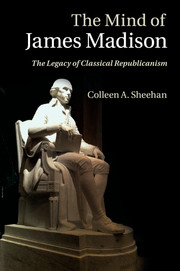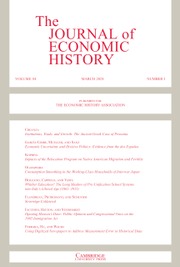The Many Panics of 1837
People, Politics, and the Creation of a Transatlantic Financial Crisis
$33.99 (G)
- Author: Jessica M. Lepler, University of New Hampshire
- Date Published: September 2013
- availability: Available
- format: Paperback
- isbn: 9781107640863
$
33.99
(G)
Paperback
Other available formats:
Hardback, eBook
Looking for an examination copy?
If you are interested in the title for your course we can consider offering an examination copy. To register your interest please contact collegesales@cambridge.org providing details of the course you are teaching.
-
In the spring of 1837, people panicked as financial and economic uncertainty spread within and between New York, New Orleans, and London. Although the period of panic would dramatically influence political, cultural, and social history, those who panicked sought to erase from history their experiences of one of America's worst early financial crises. The Many Panics of 1837 reconstructs the period between March and May 1837 in order to make arguments about the national boundaries of history, the role of information in the economy, the personal and local nature of national and international events, the origins and dissemination of economic ideas, and most importantly, what actually happened in 1837. This riveting transatlantic cultural history, based on archival research on two continents, reveals how people transformed their experiences of financial crisis into the “Panic of 1837,” a single event that would serve as a turning point in American history and an early inspiration for business cycle theory.
Read more- A riveting transatlantic cultural history
- Draws on archival research from two continents
- Argues that culture plays a powerful role within capitalism
Awards
- Co-winner of the 2013 SHEAR James H. Broussard First Book Prize
Reviews & endorsements
"Finally a historian who understands that panics were caused by people panicking. Like weather systems, economies present deep structural patterns and shifting intermediate forces, but for people in real time it was precipitating events that made the difference between great riches and financial ruin. This masterful telling of a complex tale - Dickensian in its intricacy - walks the reader through a series of moments in which individuals had no choice but to take a position that more often than not guaranteed the frightening outcome they sought to avoid. By rejecting the naturalization of economic theory, Jessica Lepler has vividly captured the world as it must have looked to the governors of the Bank of England, to the bill brokers and cotton factors of New Orleans, to Nicholas Biddle and poor old Philip Hone. The brutal market 'corrections' of 1837 (and after) stood as the defining events of the lives of this generation of Americans."
John Lauritz Larson, Purdue University, IndianaSee more reviews"In this compelling and moving account Jessica Lepler shows us how a bank war could undermine British faith in American borrowers and cause a cascade of doubts about America's future. The chain of debt is the same as five years ago, although the vividly drawn cast of characters is radically different. Compulsively readable, this will change the way you think about the intimate relationship between slavery and capitalism."
Scott Nelson, College of William and Mary, Virginia"The Many Panics of 1837 is a gripping narrative about what happened to disrupt financial markets and individual investors in 1837. But Lepler has also given us a theoretically deft account of how the history of this year has been written and why its many iterations matter. This book is essential reading for anyone interested in how we construct the past and how the past we construct shapes what we can know about the world we inhabit now."
Mary Poovey, Samuel Rudin Professor in the Humanities, New York University"Lepler combines financial, business and economic history with social, cultural and political history in a transnational context in The Many Panics of 1837 to demonstrate that human agency remains at the heart of seemingly large impersonal forces. Lepler argues persuasively in this well-written tale of three cities that the transition from the best of times to the worst of times explains the psychology of what was so panicky about the panic of 1837 … I have already adopted this book for use in my class on the early American republic."
Michael J. Gagnon, The Journal of American History"… offers cultural context for the Panic of 1837 that earlier treatments have lacked. Navigating impressively through a wealth of business correspondence and private letters of various merchants and financiers, large and small, as well as the contemporary press, Lepler paints a vivid picture of the thoughts that passed through the minds of individuals as their fortunes took a fateful turn in the spring of that year … Lepler makes the complex interactions of this market easy to understand."
Peter L. Rousseau, EH.net"Lepler defines the heretofore poorly understood Panic of 1837 in terms of human emotional response … productive, historically grounded examinations of the ways in which feelings and ideas made and were remade by the history of finance … draw[s] on ideas, culture, politics, business, institutions, law, and economics … acknowledge[s] 'real' economic change, while insisting that this change is bound up with changes in subjectivity."
Hannah Farber, Enterprise and Society"Jessica Lepler’s book on the panics of 1837 is at the very forefront of [a] new methodological approach to the history of capitalism and her work is a testament to the great insights this new approach can yield. In this vibrant and often witty work, Lepler has reconstructed the events that led to the economic crisis of 1837 on both sides of the Atlantic. Her surprising, yet convincing conclusion, is that the suspension of specie payments by New York banks on 10 May 1837 was not the beginning of the crisis, but in many ways its end. Abandoning this traditional starting point she argues that it was at this point that financial certainty began to be restored to the nation and that such certainty enabled calm to prevail."
Joanna Cohen, Reviews in History'In its careful reconstruction of the day-by-day unfolding of small, localized crises, this book provides a fascinating account of this complex series of small-scale events that eventually became known as the Panic of 1837. … [Lepler] weaves local stories into a network of international significance. … It is a complex story, to be sure, but one that's well worth taking the time to understand.' Sean Patrick Adams, Common-place
Customer reviews
Not yet reviewed
Be the first to review
Review was not posted due to profanity
×Product details
- Date Published: September 2013
- format: Paperback
- isbn: 9781107640863
- length: 356 pages
- dimensions: 226 x 152 x 25 mm
- weight: 0.48kg
- contains: 12 b/w illus. 1 map
- availability: Available
Table of Contents
Introduction: the many panics of 1837
1. A very gamblous affair
2. The pressure of 1836
3. Practical economists
4. Mysterious whispers
5. The many panics in 1837
6. Parallel crises
7. States of suspense
Epilogue: panic-less panics of 1837.
Sorry, this resource is locked
Please register or sign in to request access. If you are having problems accessing these resources please email lecturers@cambridge.org
Register Sign in» Proceed
You are now leaving the Cambridge University Press website. Your eBook purchase and download will be completed by our partner www.ebooks.com. Please see the permission section of the www.ebooks.com catalogue page for details of the print & copy limits on our eBooks.
Continue ×Are you sure you want to delete your account?
This cannot be undone.
Thank you for your feedback which will help us improve our service.
If you requested a response, we will make sure to get back to you shortly.
×










